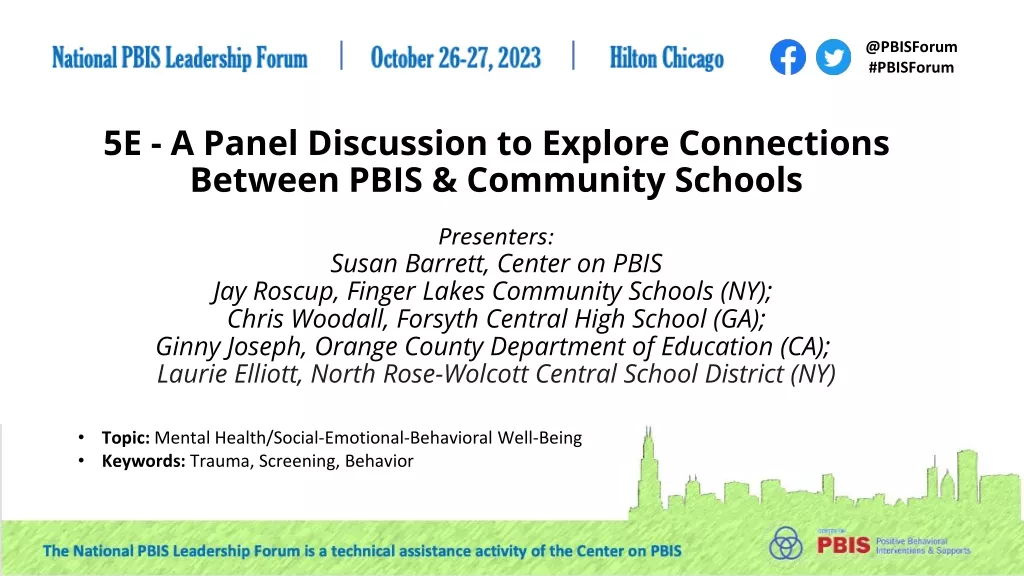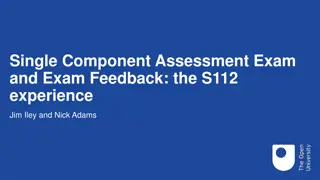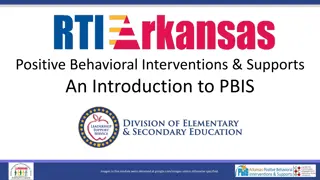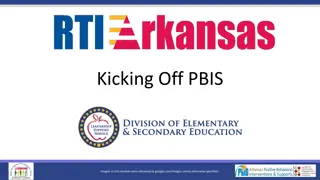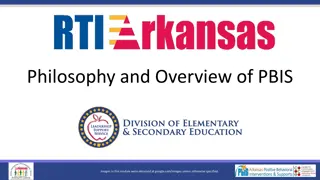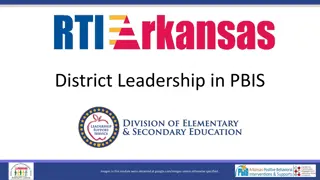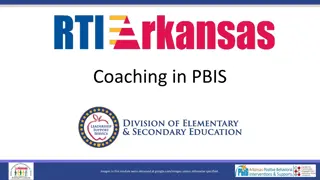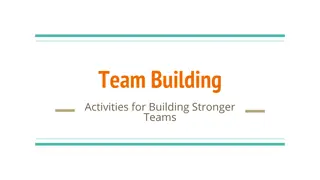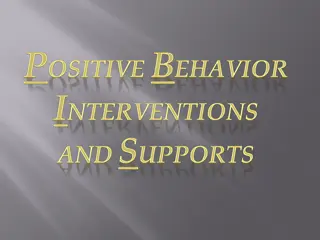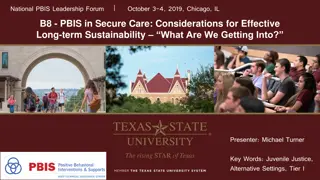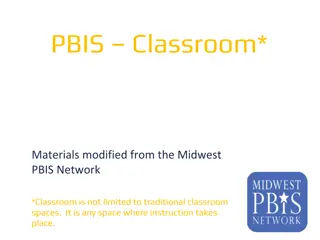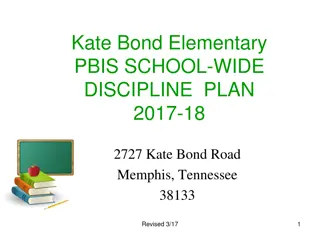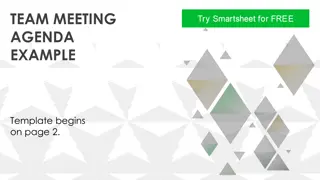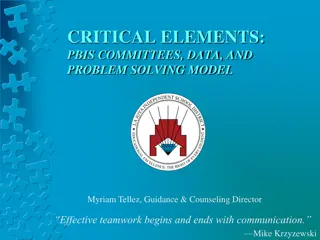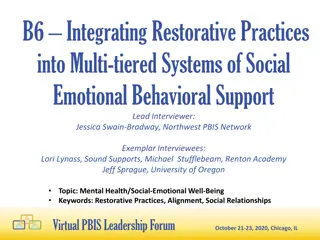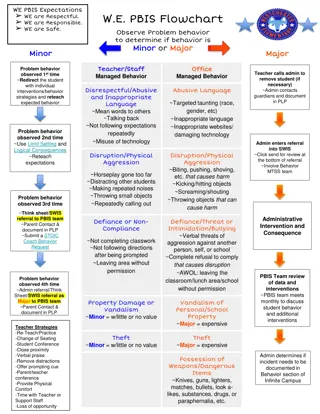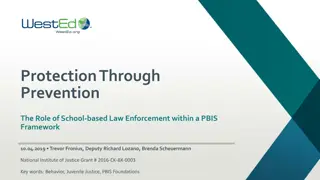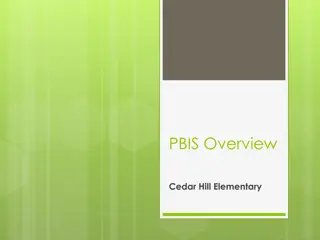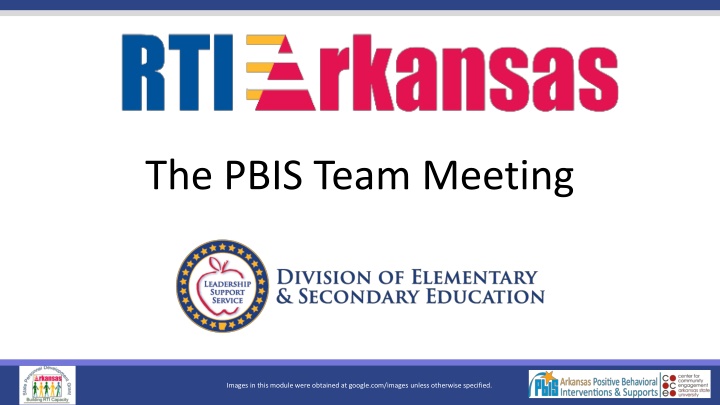
Effective PBIS Team Meeting Strategies for Success
Enhance your PBIS team meetings with strategies focusing on problem-solving, evaluation, communication, and team responsibilities. Learn about the importance of parent/community involvement, student voice, team roles, and facilitator responsibilities to drive positive outcomes in PBIS implementation.
Download Presentation

Please find below an Image/Link to download the presentation.
The content on the website is provided AS IS for your information and personal use only. It may not be sold, licensed, or shared on other websites without obtaining consent from the author. If you encounter any issues during the download, it is possible that the publisher has removed the file from their server.
You are allowed to download the files provided on this website for personal or commercial use, subject to the condition that they are used lawfully. All files are the property of their respective owners.
The content on the website is provided AS IS for your information and personal use only. It may not be sold, licensed, or shared on other websites without obtaining consent from the author.
E N D
Presentation Transcript
The PBIS Team Meeting Images in this module were obtained at google.com/images unless otherwise specified.
Context For The Team The PBIS team Meeting foundations Problem solving Evaluation Communication
School Team Responsibilities School-wide PBIS action plan Regular team meetings Communication with staff & coach Reporting outcomes to stakeholders
The PBIS Team The PBIS team represents: Grade levels across the school Different cultures across the school Specialty and special education classes The school community
Parent/Community Involvement Consider having parent representation on the team. Consider having a community member on the team. Get input/feedback from parents and community. Share action plans and outcomes.
Student Voice At the secondary level, consider having at least one student on the team. Student representation increases likelihood of student buy-in. Students can help with both planning and implementation.
Other Considerations Team members must: Be respected in the school Be good communicators Have positive attitude Be relationship builders
Assigned Team Roles Facilitator keep meeting on topic, on task Minute taker record & distribute minutes Data analyst bring data reports to meetings Active team members problem solve; input, feedback
Facilitator Responsibilities 1)Before meeting, provides agenda items to minute taker 2)Starts meeting on time 3)Determines date, time, and location of next meeting 4)At meeting, manages the flow of meeting by adhering to the agenda a)Prompts team members (as necessary) with problem solving i) Do we have a problem? ii)What is the precise nature of the problem? iii)Why does the problem exist, and what can we do about it? iv)For problems with existing solution actions (1)What is the implementation status of our solution actions - Not started? Partially implemented? Implemented with fidelity? Completed? (2)What will we do to improve implementation of our solution actions? (3)Are implemented solution actions working (i.e., reducing the rate/frequency of the targeted problem to our goal level)? b)Is active participant in meeting
Minute Taker Responsibilities 1) Before meeting a)Collects agenda items from facilitator b)Prepares Meeting Minutes form c) Prints copies of the Meeting Minutes and Problem-Solving Action Plan form for each team member, or is prepared to project form via LCD d)Set up room for meeting, table, chairs, internet connection, LCD/document camera connection e)Open documents needed for the meeting (previous meeting minutes and a saved copy with current meeting date, data access as needed) 2) At meeting, asks for clarification of tasks/decisions to be recorded in meeting minutes, as necessary a)Is active participant in meeting 3) After meeting a)Disseminates copy of completed meeting minutes to all team members within 24 hours b)Maintains electronic file of team documents
Data Analyst Responsibilities 1)Before meeting, reviews school-wide discipline data a)Identifies potential new problems with precision b)Asks facilitator to add potential new problems to list of agenda items for upcoming meeting 2)At meeting, makes the following available, as appropriate a)Report on office discipline referrals (ODRs) per day per month and Big 5 reports what, who, where, when, why (potential new problems at broad/macro level) b)Custom or other reports to: i) Identify/show potential new problems at precise/micro level ii) Confirm/disconfirm inferences regarding new problems iii) Show pre-solution data for identified problems that do not currently have implemented solution actions (items you are watching) iv) Show progress data for problems that do have currently implemented solution actions c)Is active participant in meeting
Team Member Responsibilities 1)Before meeting, recommends agenda items to facilitator 2)At meeting, responds to agenda items and a)Analyzes/interprets data; determines if a new problem exists b)Ensures new problems are defined with precision (what, who, where, when, why) c)Discusses/selects solutions for new problems d)For problems with existing solution actions i)Reports on implementation status (Not started? Partially implemented? Implemented with fidelity? Completed? ii)Suggests how implementation of solution actions could be improved iii)Analyzes/interprets data to determine whether implemented solution actions are working (i.e., reducing the rate/frequency of the targeted problem to our goal level)? e)Is active participant in meeting
The PBIS Team Meeting Foundations Purpose & agreements Membership Meeting schedule (including location) Agenda Data collection & data entry schedule Data reporting schedule
Examples Team Purpose Team Agreements Inform facilitator of absence/tardy before meeting Avoid side talk Stay focused and active Start and end on time Coordinate implementation of Tier I systems and supports Monitor fidelity of implementation and overall status of progress towards goals
Example: Team Meeting Schedule Team Meeting Schedule Start/End Time Meeting Minute Location When Where Tier I Meeting Minute folder on shared drive 3rd Thursdays, monthly Room 103 2:45-3:45
The Main Focus Of The PBIS Team Meeting
Examples: Data & Reporting Schedules Data Collection & Data Entry Schedule What, Who & When TFI Nov, Feb, April - Tier I Team completes during meeting Teacher surveys as needed Student GPS Data Attendance Data DIBELS Report Generation What, Who & When Question Use sub-scale Reports and raw data to determine implementation plan Fidelity of Implementation Tier I team reviews Quarterly Student Outcomes Fall Winter Spring
Meeting Goals Identify, address, and resolve students' social and academic behavior problems. Use data to inform decision making.
Judy Elliotts Problem-Solving Process DESE is using Judy Elliott s four-stage problem solving process for all RTI: 1. Define the problem and set a goal. 2. Analyze the problem and hypothesize. 3. Develop and implement the plan. 4. Evaluate the plan. Elliott, 2015
Judy Elliott - Tier 1 Problem Solving 1. Define/identify precise problem What are the behavioral problems in the school? Identify goal for change 2. Hypothesize reason for problem and solution 3. Implement solution with integrity 4. Evaluate the impact of solution Compare with goal Make summative evaluation decision
Step 1. Identify A Precise Problem What is the behavior? Where is it happening? When is it happening? Who is involved? Why? What is the motivation?
Example Of A Precise Problem Statement There are many referrals for fighting on the playground. Most of these referrals are happening between 9:15 and 10:15 am among 3rd and 4th graders. The motivation appears to be wanting to obtain sports equipment.
Identify A Goal For Change Goal: definition of success Detailed, with timeline At what point is the identified problem no longer a concern? At what point are the frequency and duration of the behavior at acceptable levels?
Example Of A Goal With Timeline Using the precise problem statement from earlier: Goal: 75% reduction in referrals for playground fighting within one month.
Step 2. Analyze The Problem & Develop Hypothesis Developing informed statements about why the desired behavior(s) is not occurring The (desired behavior) is not occurring because Elliott, 2015
Step 3. Identify A Solution, Create A Plan Guiding questions: What are you going to do to bring about the desired change? What will remove the barriers to success?
Creating A Plan Solution strategies: Prevention Teaching Recognition Extinction Consequences Also, plan should include WHO will do WHAT by WHEN Evaluation plan
Solution Strategies When? Who is Responsible?
Step 4. Monitor The Impact Evaluate your plan: Did it work? Are we solving the problem? Has the desired goal been achieved? Use data to determine the impact.
Make A Decision What next? Modify strategy? Maintain the goal? How? Revise the goal? Reconsider feasibility? Redefine the precise problem?
Implement With Integrity Was the plan implemented correctly? Use data from previously determined sources (e.g., checklist)
Communication Share data with staff & district coach Provide annual update to school board Conduct surveys to gain input Provide info on website Involve local media Provide newsletters to parents & others
Do It With Fidelity! Tiered Fidelity Inventory (TFI) Efficient, valid index of extent to which PBIS core features are in place Section 1.2 Team Operating Procedures
1.2 Team Operating Procedures Subscale: Teams Scoring Criteria 0 = Not implemented 1 = Partially implemented 2 = Fully implemented 0 = Tier I team does not use regular meeting format/agenda, minutes, defined roles, or a current action plan. Feature Data Sources Tier I team meeting agendas and minutes Tier I meeting roles descriptions Tier I action plan 1.2 Team Operating Procedures: Tier I team meets at least monthly and has (a) regular meeting format/agenda, (b) minutes, (c) defined meeting roles, and (d) a current action plan. 1= Tier I team has at least two but not all four features. 2 = Tier I team meets at least monthly and uses regular meeting format/agenda, minutes, defined roles, AND has a current action plan. Main Idea: Specific features are necessary to ensure meetings are effective for action planning and tracking progress.
Summary Create a good foundation for efficient/effective meetings Focus on data-based, precise problem solving Develop complete action plans Monitor and evaluate progress of action plans

